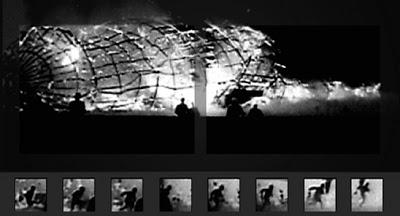by Paul J. Pelkonen

Footage from Hindenburg, part of Steve Reich's Three Tales.
Image by Beryl Korot © 2002 Nonesuch Records.
Minimalism uses small melodic and rhythmic cells, intricate percussion and long chains of repetition and repetition to create a hypnotic effect, drawing the listener in over time. Mr. Reich often uses pairs of instruments, playing in unison or antiphon, soaring minor-key lines for voice or strings, and a vast battery of percussion instruments, from vibraphones to conventional drum sets, always appearing in pairs.
The performance opened with Quartet, a work that had its premiere in 2014 downstairs at Zankel Hall. The piece is played at two pianos and two vibraphones, the latters played with multiple mallets held in the hands of each soloist. The first movement was an experiment in phase differentials, as the four instruments played in pairs that slowly differentiated. The music rapidly shifted in rhythm, playing staccato figures and using the simple fragments to create elaborate structures: a cathedral of sound built from tiny Lego®-like bricks.
A slow movement followed without pause, with the malletteers using the sustaining features of their vibraphones to create long, ringing sounds that sounded like the peal of distant bells. The pianists also created the sustain effect with their pedals, unfolding a slow, ethereal magic that seemed to hover in the air. The final movement was fast again, with the taut, propulsive momentum of the opening but with the four instrumental voices telling an infinitely more complex story.
Next was the Carnegie Hall premiere of Pulse under the baton of David Robertson. This was a Carnegie Hall commission, a new piece chosen to start Mr. Reich's year as the venue's Composer in Residence. Here, paired strings and wind instruments carried Mr. Reich's message forward, driven by a relentless two-note drone played by a bass guitar. This was deep and meditative music, amorphous in shape and meant to seduce the ear with the simplicity of its utterance.
The second half of the evening featured Three Tales. Each movement or "tale" confronts a disaster and/or scientific breakthrough of the 20th century. The opening Hindenburg recounts the final flight and fiery crash of the German zeppelin at Lakewood, NJ. Mr. Reich and Ms. Korot weave together newsreel footage, eyewitness accounts and the singers reading snippets of newspaper accounts. In one sequence, silhouetted workers appeared building the great skycraft, their hammered rhythms lifted from Wagner's Das Rheingold.
Hindenburg was followed by Bikini, chronicling the displacement of Micronesian islanders and the repeated atomic testing at the Bikini Atoll in the South Pacific. The last movement, Dolly conflated the successful cloning of the sheep by that name with a rumination on robotics and artificial intelligence, including important scientific and religious figures, their words chopped, edited and occasionally interrupted by the appearance by a talking, child-like robot. When Mr. Reich attempted to unify all three themes in a sort of grand finale, Three Tales sank under its own weight.

